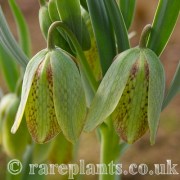Description
It is a comparatively rare plant, yet strong-growing plant, restricted to the upper reaches of Mount Hermon in Lebanon and the Anti-Lebanon range between Lebanon and Syria, which is where this stock comes from. It is characterised by having dwarf growths, with stems only 5-8 cm tall, but it carries large, well-marked flowers, each up to 2 cm long. These are jade green with diffuse chequering on the outer set of petals but this is much darker and more pronounced on the inner set.
The related and quite widely-spread plant once known as F. hermonis amana (now regarded as a distinct species F. amana) has persisted in cultivation for at least 70 years, during which time the type species offered here has barely entered cultivation but it seems now to be both established and thriving.
Readily grown but still rare. We use a loam-based compost, with good drainage and give a dry summer rest (though not “a bake” as, in common with all Fritillaria, the dormant bulbs have no bulb tunic to help prevent desiccation).


